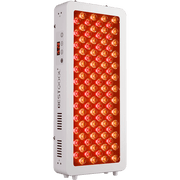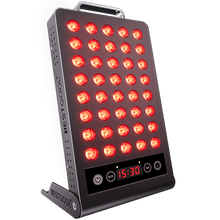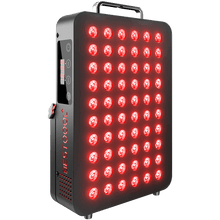Why Is Everyone Talking About Red Light for Pets?
More and more pet owners nowadays are searching for natural, non-surgical treatments—and red light therapy is one of the up-and-coming options that's being debated. Originally created for human health, the therapy uses light wavelengths to stimulate healing within the body.
It's now being considered a method for easing joint pain, muscle spasms, and recovery issues in pets. The interest is growing not only as a result of the science but also because it is a gentle way to assist in supporting pet health at home.

Understanding Red Light Therapy for Animals
Red light therapy applies low-level red and near-infrared light to specific areas of the body. The light waves penetrate through the skin to cells and stimulate the mitochondria, also known as the "powerhouse" of cells. Cellular energy is increased as a result, which promotes tissue repair, reduces inflammation, and provides pain relief. The process in animals is completely non-invasive, silent, and painless and ideal for animals that may be resistant to other treatments.
Potential Wellness Benefits for Your Furry Companion
The therapy can support a wide range of health concerns in pets. It may help reduce swelling and stiffness in arthritic joints, speed up recovery after surgery or injury, and ease muscle tension after strenuous activity. Red light exposure also appears to promote healthy skin by improving circulation and encouraging natural collagen growth. Over time, many pet owners report improvements in mobility, comfort, and even coat shine—especially in aging animals or those with chronic conditions.
The Complete Safety Checklist for Pet Owners
Safety above all when using red light therapy devices at home. Precautions for safety to bear in mind are:
- Use Eye Protection: Both humans and animals must protect their eyes. Choose proper safety goggles for yourself and shield your pet’s eyes with vet-approved solutions when needed.
- Begin with Short Sessions: Start with 5 to 10 minutes per treatment area. Monitor how your pet responds, and only increase the duration gradually.
- Look for Discomfort: If your pet moves away, exhibits restlessness, or becomes agitated, stop the session. A relaxed attitude is the goal.
How to Choose the Right At-Home Therapy Device
Not all red light devices are made for pets—or safe for home use. Keep these features in mind when selecting your device:
- Therapeutic Wavelengths: Look for devices that emit light between 600–940 nm because this range is clinically shown to aid healing.
- Optimal Power Output: Devices with extremely low irradiance won't work, and those with extreme intensity should be used carefully. An even output is optimal.
- Quality Manufacturing: Choose a reputable brand that is safety-tested. Independent testing and customer reviews are excellent quality indicators.
Finding the Correct Dosage for Your Pet
Red light therapy works to a large extent based on dosage. "Dosage" refers to the length of time it is applied, proximity to the skin, and frequency of treatments.
Larger animals take longer periods of exposure or more than one treatment area, and small animals generally do best with brief sessions. More chronic conditions will work best with intensive therapies (e.g., every other day), while less severe conditions or post-operative recuperation will do best with fewer. Make the routine of the sessions for the best outcome, and always change as needed on how your pet is responding.
A Step-by-Step Guide to a Calm Therapy Session
Creating a relaxed setting is just as important as applying the light correctly. Here’s how to structure a smooth session:
- Set the Scene: Choose a quiet room without loud noises or distractions. Dim the lights if possible.
- Get Comfortable: Place your pet in a cozy bed or gently hold them in position. Support the area that needs treatment.
- Start the Session: Position the device as the manufacturer suggests. Avoid shining the light in your pet’s eyes.
- Calm Your Pet Down: Talk gently or pet them. Reward praise or treats afterward so that subsequent sessions are easy.

When to Stop and What Signs to Watch For
While low-risk, red light therapy must be discontinued when something seems off:
- Indications of Distress: Panting, pacing, or efforts to leave the room may indicate that your pet is distressed or the dose is too high.
- Skin Irritation: Watch for redness, rashes, or burns on treated skin.
- Changes in Behavior: Sedation, loss of appetite, or increased sensitivity after treatment may indicate sessions are too long or too frequent.
Always adjust treatment as required—and if uncertain, stop therapy and speak with your vet.
Why You Should Always Talk With Your Vet First
Before adding red light therapy to your pet’s care routine, professional input is essential. Your veterinarian can confirm whether the therapy fits your pet’s specific condition and suggest an appropriate treatment plan. This ensures that light therapy works alongside, not against, any ongoing medications, recovery timelines, or chronic health concerns. Even if the device is designed for pets, every animal is different—and a vet’s insight is the safest way to begin.
Red light therapy can be a helpful tool for improving your pet’s comfort, mobility, and overall wellness—especially when used with care and proper planning. With the right device, a calm environment, and professional guidance, many pet owners have seen real benefits. If you're looking for a simple, drug-free way to support your pet’s health, red light therapy may be worth considering.
Frequently Asked Questions (FAQs)
Q1. Can red light therapy be used on all types of pets?
Yes, it is generally safe for dogs, cats, rabbits, and other small mammals. Just make sure you check with your vet first, though—some pets have certain health problems that require special care.
Q2. How often should I use red light therapy on my pet?
That will depend on the size, health, and desired treatment of your pet. Chronic pain may be required 2–3 times per week, whereas minor problems can be used perhaps only occasionally. Your veterinarian can advise on the best regimen.
Q3. Can red light therapy help with behavioral issues in pets?
It is not meant to cure behavior, but some animals do appear less upset after sessions. If your pet's behavior is altered, however, always consult a vet or behaviorist.
Q4. What are the signs that red light therapy is working for my pet?
You might notice more motion, better disposition, less stiffness, or more rapid recovery. These changes tend to grow with repeated sessions.
Q5. Is red light therapy safe for older pets or pets with health issues?
Yes, especially since it does not involve the use of drugs or surgery. Older pets, however, might need fewer or shorter sessions. Consultation with a vet is always a must prior to treatment.
Q6. Can red light therapy be combined with other treatments like physical therapy or medications?
Yes, red light treatment is typically given as an adjunct treatment in addition to physical therapy, anti-inflammatory drugs, or other treatment protocols prescribed by the vet. Because it's non-invasive and has minimal side effects, it typically complements standard treatments nicely. But timing and dosing should also be closely watched so that overstimulation and counterproductive effects do not occur. Always consult your vet to coordinate an integrated care strategy that's safe and effective for your pet's situation.














 Small
Small

 Moderate
Moderate

 Moderate
Moderate

 Moderate
Moderate

 Full
Full



